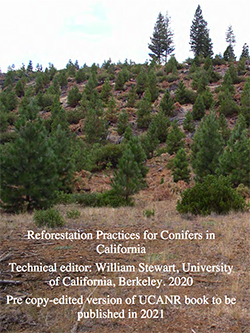New UC Book Offers Insight Into How Landowners Can Reforest Lands Ravaged by Wildfires
"Reforestation Practices for Conifers in California" is available immediately for free viewing and download at www.fvmc.org. This document provides landowners and managers detailed, step-by-step information about their options for reforesting their land.

“The primary takeaway from this book is that the most successful reforestation happens if planning begins as soon as the flames die down,” said Dr. Bill Stewart, Co-Director, Berkeley Forests. “The manual presents a planning process, with a detailed explanation of the options at each step. These basic steps are the same for a small landowner, large landowner, or an agency.”
The recommended practices are the result of 50 years of concentrated effort to improve reforestation success and reduce costs under the difficult conditions present in most of California. Significant lessons have been learned since the last reforestation manual for California was published in 1971. The 16 coauthors of the new book present the best practices gleaned from their combined experience of planting over 100 million conifer seedlings on hundreds of thousands of acres of public and private land in the state. Funding for the preparation of this book was provided by the California Department of Forestry and Fire Protection (CAL FIRE), the U.S. Forest Service, and private donors.
Successful reforestation is nothing like landscaping a yard and going down to the nursery to buy a few fruit trees to plant and water in your backyard. Because reforesting burned forestland depends on natural precipitation and not costly irrigation systems, reforestation requires careful evaluation of the site and the availability of locally adapted native seeds. If seeds are available, then foresters prescribe treatments for the site and the quantity of seedlings of each species needed. Over the next two years, the forester will plan and implement site preparation, plant nursery grown seedlings, and arrange follow-up treatments as needed.
Bob Rynearson of W. M. Beaty & Associates, Inc, a forestland consulting firm in Redding, California and one of the book’s authors explains, “Experience has shown controlling competing vegetation results in the retention of sufficient soil moisture for excellent seedling survival rates, even on very dry sites during prolonged droughts, when high quality, locally adapted native seedlings are planted properly. If you don’t properly plan and implement the sequence of each time-critical reforestation step, then you’re probably wasting your money, time, and valuable conifer seed.”
“To maintain the carbon capturing potential of our forests, significant investments in effective
reforestation on private and public forest lands will be necessary,” said Dr. Stewart. “The bottom line is that achieving success is critical if the growing backlog of California’s fire damaged forests are to once again be filled with healthy trees.”
The president of the non-profit organization Forest Landowners of California, Claire McAdams, is enthusiastic in support of the book: “The loss of family forests due to wildfires, often after one or more decades of ownership and careful husbandry, is emotionally gut wrenching. The new Reforestation Practices for Conifers in California publication by UCANR is an excellent guide to both the process and issues facing non-industrial forestland owners seeking to reforest their land. This publication belongs on everyone’s reference shelf.”
About Dr. Bill Stewart and Berkeley Forests
Bill Stewart of the University of California’ Berkeley Forests and Agricultural and Natural Resources is the technical editor for the project. “The final book includes more than 500 pages, 200 figures, and 800 scientific references. It will be a valuable resource for landowners, practitioners, and policy makers” he said. The process involved 16 co-authors and more than 25 peer reviewers. Given the time sensitive need to get this information out in the public arena while UCANR is completing the copy editing, final high quality illustrations, and hard copy publication, we agreed to post all of the peer reviewed chapters for easy download on the Forest Vegetation Management Conference website, noted Stewart. The Forest Vegetation Management Conference made major contributions to both the accumulation of the new knowledge that led to this book’s creation and to the process that led to this book becoming a reality rather than just an idea.
Contact:
Bill Stewart
UC Berkeley
billstewart@berkeley.edu
(510) 318-0377
